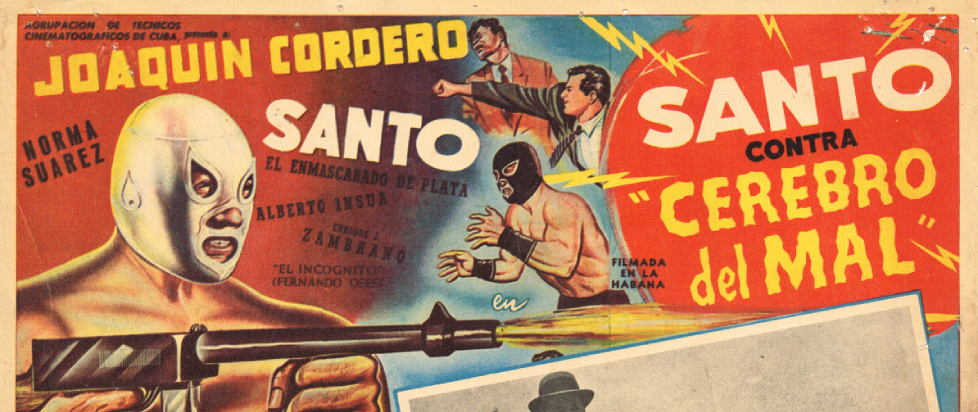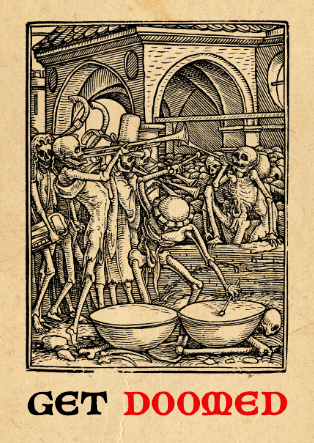
For the Good of All Mankind: The Two Earliest Films Starring the Silver Masked Man
“I have to confess that I don’t really know anything about Mexican wrestlers,” Mike Mignola wrote in the author’s notes to Hellboy in Mexico. “I’ve never seen any of the movies, but I sure like the idea of them.”
That was me, pretty much, until a few years ago. Everything I knew about lucha libre came from secondhand cultural osmosis, and the closest I had ever come to any of the films was the Mystery Science Theater 3000 episode featuring the K. Gordon Murray dub of Santo contra las Mujeres Vampiro – the seventh of an extremely long line of films featuring El Santo, easily the most famous luchador enmascarado of all time.
Which brings us to the present. Things have changed a bit since then. I’m still not going to act like I know very much about lucha libre but I have, at least, seen a few more of the movies, including Santo in the Wax Museum, Santo and Blue Demon vs. the Monsters, and even the occasional non-Santo lucha libre film, such as Curse of the Aztec Mummy, which features a wrestler character called “the Angel” that is pretty obviously intended as a stand-in for El Santo.
My experience in this realm is still much less robust than I would like it to be, however. So I jumped at the chance to tackle this release from Indicator, a Blu-ray double-feature of the first two movies to star El Santo himself, both originally filmed in 1958 and released in 1961.

“These scientists don’t get much rest.” – Santo vs. the Evil Brain (1961)
The first Santo film has almost no Santo in it. Let’s just get that out of the way right up front. In fact, it’s about 40% scenes of cars driving slowly around, and another 20% establishing shots of docks. The remainder of the film is made up of a mix of people having dinner, musical and dance numbers, and an occasional wrestling match. Also, Santo spends the vast majority of the film hypnotized by the mad scientist villain and therefore serving the bad guys.
And yet, Santo is introduced in such a way that we in the audience are obviously intended to already know who he is. He’s given no origin story or background, with the police lieutenant referring to him, at one point, as “one of our best agents,” and everyone who sees him, from the bad guys to the heroes, immediately knowing who he is and what he’s about. And Rodolfo Guzman Huerta, the man who was El Santo, with almost no lines, nonetheless demonstrates his stage presence, even if he is not yet an actor.
When Santo is hypnotized, his movements and bearing change. The characters call him robotic, but today we would see him as more like a mix between a zombie or an ape. Even the way he sits changes. The hypnotized Santo slouches and slumps in a way that the legendary Silver Masked Man never would. There’s also another masked wrestler in The Evil Brain, one whose presence is every bit as significant as Santo’s.
In the film, this is a fellow agent of good called El Incognito, who actually gets to accomplish a whole lot more than Santo ever manages, thanks to the title character’s aforementioned indisposition throughout most of the picture. What is noteworthy, however, is that El Incognito is played by fellow wrestler Fernando Oses, who co-wrote this and many of the other Santo movies, and appears, in various roles, throughout them.
Though not released in Mexico until 1961, both The Evil Brain and its companion film in this set were filmed in Cuba during the revolution, with crews made up primarily of Cuban technical personnel. The booklet that accompanies the Blu-rays recounts an anecdote told by Joaquin Cordero, the actor who plays the villainous mad scientist in Evil Brain and the heroic Joaquin in Infernal Men, that the crew were cautioned to “crouch down when they heard shots.” Cordero goes on to state that the filming was over in a hurry, and that they “left the island just an hour before Fidel Castro entered Havana.”
Perhaps this goes some distance toward explaining the rather slapdash nature of the two films, what an essay in the booklet calls their “careless execution.” More likely, the state of the pictures can be attributed to the fact that they were the first of their kind, filmed simultaneously, on a shoestring budget and in quite a hurry. As a result, both films feel like a patch-up job, with large sections seemingly shot silent with sound then dubbed in later.
They also feel like something that is still finding its footing. While the opening credits of Evil Brain point out that it is the first “cinematic presentation of Santo,” it was not until the third Santo film, Santo vs. the Zombies, in 1962, that the Santo character was officially registered by the Film Production Workers’ Union.
Zombies, the earliest of the Santo films to be re-dubbed and released in the United States – as Invasion of the Zombies – also feels more of a piece with the more than fifty films that were still to come in Santo’s filmography, which see the masked wrestler going up against Martians, monsters, ghosts, vampires, head-hunters, the mafia, mummies, inquisitors, werewolves, Dr. Frankenstein, La Llorona, and many more.

“We had to take a big detour.” – Santo vs. the Infernal Men (1961)
Reusing numerous shots – not to mention cast and crew – from Evil Brain, Santo is barely in this movie, either. Indeed, he might play an even more minor role in Infernal Men, acting as a phantom that haunts the edges of a straightforward story about an agent who goes undercover to infiltrate a group of smugglers.
Even as the plot is less ambitious, however, the movie is possibly more so. While watching the two in order is tedious, as probably a full reel of film is reused between them, the scenes likely fit better here than in Evil Brain, and while Santo is just as scarce this time around, his presence feels more like what we’re used to from later films. He shows up in a convertible to save the day, and operates on the fringes of what is basically a secret agent plot filled with notes passed via matchbooks and secret messages written on money.
Santo vs. the Infernal Men may have precious few set pieces, but the few it does have are at least marginally more exciting than those of its sibling film, as well. There’s even a chase through part of an abandoned Coney Island amusement park, which the booklet describes as “an unimaginative imitation of the famous conclusion to The Lady from Shanghai.”
In spite of these improvements, there’s still not a lot to recommend Infernal Men except as a historical curiosity. As Santo movies go, much better ones are still in the offing. This set from Indicator is less about two movies that you’ll want to put into your regular rotation, however, as it is about giving audiences access to films of historical note that might otherwise be lost to time. These may not be much fun to watch, but it’s extremely nice that we get the opportunity, nonetheless.
With Santo himself largely absent, the story in Infernal Men instead focuses on the heroic undercover officer, played by Joaquin Cordero, who had the bad guy part in Evil Brain. It’s even got a halfhearted attempt at a framing story, as we see the film’s climax at the beginning, and then flash back to how things ended up that way. Ultimately, both pictures end with the same footage of an airplane taking off, ostensibly ferrying two different newlywed couples to new lives together, guarded by one or two masked wrestlers who are along for the ride.
Both also end with variations on the same monologue from Enrique Zambrano, the other half of the films’ co-writing team, explaining to the audience why the Masked Man (or men) keep their identities a secret: “They are citizens of the world. Their duty knows no borders. They use masks to hide their identity for the good of all mankind.”
———
Orrin Grey is a writer, editor, game designer, and amateur film scholar who loves to write about monsters, movies, and monster movies. He’s the author of several spooky books, including How to See Ghosts & Other Figments. You can find him online at orringrey.com.


